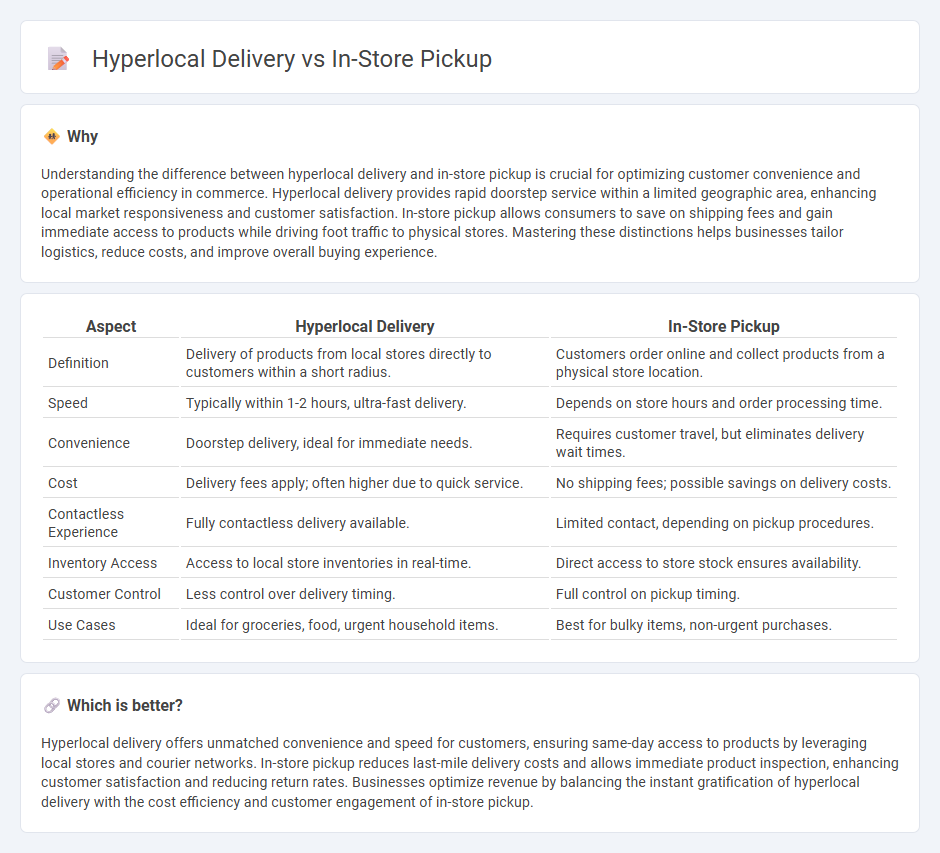
Hyperlocal delivery enables customers to receive purchases within hours, leveraging local courier networks and real-time inventory updates for rapid fulfillment. In-store pickup offers immediate product retrieval, reducing shipping costs and enhancing customer convenience by allowing buyers to collect orders directly from nearby retail locations. Explore the benefits and challenges of these fulfillment methods to optimize your commerce strategy.
Why it is important
Understanding the difference between hyperlocal delivery and in-store pickup is crucial for optimizing customer convenience and operational efficiency in commerce. Hyperlocal delivery provides rapid doorstep service within a limited geographic area, enhancing local market responsiveness and customer satisfaction. In-store pickup allows consumers to save on shipping fees and gain immediate access to products while driving foot traffic to physical stores. Mastering these distinctions helps businesses tailor logistics, reduce costs, and improve overall buying experience.
Comparison Table
| Aspect | Hyperlocal Delivery | In-Store Pickup |
|---|---|---|
| Definition | Delivery of products from local stores directly to customers within a short radius. | Customers order online and collect products from a physical store location. |
| Speed | Typically within 1-2 hours, ultra-fast delivery. | Depends on store hours and order processing time. |
| Convenience | Doorstep delivery, ideal for immediate needs. | Requires customer travel, but eliminates delivery wait times. |
| Cost | Delivery fees apply; often higher due to quick service. | No shipping fees; possible savings on delivery costs. |
| Contactless Experience | Fully contactless delivery available. | Limited contact, depending on pickup procedures. |
| Inventory Access | Access to local store inventories in real-time. | Direct access to store stock ensures availability. |
| Customer Control | Less control over delivery timing. | Full control on pickup timing. |
| Use Cases | Ideal for groceries, food, urgent household items. | Best for bulky items, non-urgent purchases. |
Which is better?
Hyperlocal delivery offers unmatched convenience and speed for customers, ensuring same-day access to products by leveraging local stores and courier networks. In-store pickup reduces last-mile delivery costs and allows immediate product inspection, enhancing customer satisfaction and reducing return rates. Businesses optimize revenue by balancing the instant gratification of hyperlocal delivery with the cost efficiency and customer engagement of in-store pickup.
Connection
Hyperlocal delivery and in-store pickup both enhance customer convenience by minimizing wait times and leveraging proximity to physical retail locations. These fulfillment methods optimize inventory management and improve last-mile logistics efficiency, driving higher customer satisfaction and increased sales. Retailers integrate real-time inventory data to seamlessly switch between hyperlocal delivery and in-store pickup, ensuring flexible, fast, and cost-effective order fulfillment.
Key Terms
Fulfillment Method
In-store pickup enables customers to collect purchases directly from physical store locations, reducing last-mile delivery costs and enhancing immediate product availability. Hyperlocal delivery focuses on rapid, often same-day shipping within a limited geographic area, leveraging local warehouses or dark stores to ensure speedy fulfillment. Explore the advantages and challenges of each fulfillment method to optimize your retail strategy.
Delivery Radius
In-store pickup limits customers to collecting items only at physical store locations, while hyperlocal delivery extends service within a defined delivery radius, often spanning a few miles from the store. Hyperlocal delivery leverages local logistics to provide faster shipping times and greater convenience for consumers within urban and suburban areas. Explore the benefits and challenges of each option to optimize your retail fulfillment strategy.
Inventory Management
In-store pickup streamlines inventory management by allowing customers to reserve products directly from the nearest store, minimizing stock discrepancies and improving turnover rates. Hyperlocal delivery requires real-time tracking and dynamic allocation to balance inventory between fulfillment centers and local demand hotspots, increasing the complexity of stock management systems. Explore effective strategies to optimize inventory across both fulfillment models for enhanced operational efficiency.
Source and External Links
In-Store Pickup: Streamline Your Shopping Today - Kohl's In-Store Pickup allows customers to buy products online and conveniently collect them from a local store, receiving email notifications when the order is ready, and presenting ID or order confirmation upon pickup.
Order Pickup - Curbside, Drive-Thru & In-Store - Walgreens offers a Pickup service where customers can order online and pick up their orders at the store in as little as 30 minutes, with options including curbside, drive-thru, and in-store pickup, accompanied by notification emails and texts.
Same Day In-Store Pickup - JCPenney provides a Free Same Day Pickup option for orders placed two hours before store closing, with the choice of curbside or in-store pickup and email notifications when the order is ready; orders not available for same day can be shipped to store for free.
 dowidth.com
dowidth.com